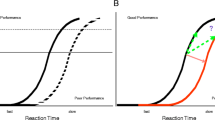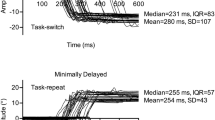Abstract
The present study investigated the contribution of the presence of a visual signal at the saccade goal on saccade trajectory deviations and measured distractor-related inhibition as indicated by deviation away from an irrelevant distractor. Performance in a prosaccade task where a visual target was present at the saccade goal was compared to performance in an anti- and memory-guided saccade task. In the latter two tasks no visual signal is present at the location of the saccade goal. It was hypothesized that if saccade deviation can be ultimately explained in terms of relative activation levels between the saccade goal location and distractor locations, the absence of a visual stimulus at the goal location will increase the competition evoked by the distractor and affect saccade deviations. The results of Experiment 1 showed that saccade deviation away from a distractor varied significantly depending on whether a visual target was presented at the saccade goal or not: when no visual target was presented, saccade deviation away from a distractor was increased compared to when the visual target was present. The results of Experiments 2–4 showed that saccade deviation did not systematically change as a function of time since the offset of the target. Moreover, Experiments 3 and 4 revealed that the disappearance of the target immediately increased the effect of a distractor on saccade deviations, suggesting that activation at the target location decays very rapidly once the visual signal has disappeared from the display.




Similar content being viewed by others
Notes
It should be noted, however, that the results of Walker et al. (2006) regarding a relationship between deviation and latency did not show a linear trend. Instead, it appeared that the amount of deviation away from a distractor reached an asymptote; it is conceivable that at longer latency the amount of deviation may start to decrease again.
References
Aizawa H, Wurtz RH (1998) Reversible inactivation of monkey superior colliculus I Curvature of saccadic trajectory. J Neurophysiol 79(4):2082–2096
Doyle M, Walker R (2001) Curved saccade trajectories: voluntary and reflexive saccades curve away from irrelevant distractors. Exp Brain Res 139(3):333–344
Doyle MC, Walker R (2002) Multisensory interactions in saccade target selection: curved saccade trajectories. Exp Brain Res 142(1):116–130
Edelman JA, Goldberg ME (2001) Dependence of saccade-related activity in the primate superior colliculus on visual target presence. J Neurophysiol 86(2):676–691
Edelman JA, Goldberg ME (2003) Saccade-related activity in the primate superior colliculus depends on the presence of local landmarks at the saccade endpoint. J Neurophysiol 90(3):1728–1736
Erkelens AJ, Sloot OB (1995) Initial directions and landing positions of binocular saccades. Vision Res 35(23–24):3297–3303
Everling S, Dorris MC, Klein RM, Munoz DP (1999) Role of primate superior colliculus in preparation and execution of anti-saccades and pro-saccades. J Neurosci 19(7):2740–2754
Everling S, Fischer B (1998) The antisaccade: a review of basic research and clinical studies. Neuropsychologia 36(9):885–899
Fischer B, Boch R (1981) Enhanced activation of neurons in prelunate cortex before visually guided saccades of trained rhesus monkeys. Exp Brain Res 44(2):129–137
Gnadt JW, Bracewell RM, Andersen RA (1991) Sensorimotor transformation during eye movements to remembered visual targets. Vision Res 31(4):693–715
Godijn R, Theeuwes J (2002) Programming of endogenous and exogenous saccades: evidence for a competitive integration model. J Exp Psychol Hum Percept Perform 28:1039–1054
Godijn R, Theeuwes J (2004) The relationship between inhibition of return and saccade trajectory deviations. J Exp Psychol Hum Percept Perform 30(3):538–554
Hallet PE (1978) Primary and secondary saccades to goals defined by instructions. Vision Res 18:1279–1296
Hallet PE, Adams BD (1980) The predictability of saccadic latency in a novel voluntary oculomotor task. Vision Res 20:329–339
Kingstone A, Klein RM (1993) Visual offsets facilitate saccadic latency: does predisengagement of visuospatial attention mediate this gap effect? J Exp Psychol Hum Percept Perform 19(6):1251–1265
Kopecz K (1995) Saccadic reaction times in gap/ overlap paradigm: a model based on integration of intentional and visual information on neural dynamic fiels. Vision Res 35:2911–2925
Krappmann P, Everling S, Flohr H (1998) Accuracy of visually and memory-guided antisaccades in man. Vision Res 38(19):2979–2985
Ludwig CJH, Gilchrist ID (2003) Target similarity affects saccade curvature away from irrelevant onsets. Exp Brain Res 152(1):60–69
Ludwig CJ, Mildinhall JW, Gilchrist ID (2007) A population coding account for systematic variation in saccadic dead time. J Neurophysiol 97(1):795–805
Massen C (2004) Parallel programming of exogenous and endogenous components in the antisaccade task. Q J Exp Psychol A 57(3):475–798
McPeek RM, Han JH, Keller EL (2003) Competition between saccade goals in the superior colliculus produces saccade curvature. J Neurophysiol 89(5):2577–2590
McPeek RM, Keller EL (2001) Superior colliculus activity related to concurrent processing of saccade goals in a visual search task. J Neurophysiol 87(87):1805–1815
McPeek RM, Skavenski AA, Nakayama K (2000) Concurrent processing of saccades in visual search. Vision Res 40:2499–2516
McSorley E, Haggard P, Walker R (2004) Distractor modulation of saccade trajectories: spatial separation and symmetry effects. Exp Brain Res 155(3):320–333
McSorley E, Haggard P, Walker R (2005) Spatial and temporal aspects of oculomotor inhibition as revealed by saccade trajectories. Vision Res 45(19):2492–2499
McSorley E, Haggard P, Walker R (2006) Time course of oculomotor inhibition revealed by saccade trajectory modulation. J Neurophysiol 96(3):1420–1424
Mokler A, Fischer B (1999) The recognition and correction of involuntary prosaccades in an antisaccade task. Exp Brain Res 125:511–516
Munoz DP (2002) Commentary: saccadic eye movements: overview of neural circuitry. Prog Brain Res 140:89–96
Munoz DP, Everling S (2004) Look away: the anti-saccade task and the voluntary control of eye movement. Nat Rev Neurosci 5(3):218–228
Olk B, Kingstone A (2003) Why are antisaccades slower than prosaccades? A novel finding using a new paradigm. Neuroreport 14(1):151–155
Port NL, Wurtz RH (2003) Sequential activity of simultaneously recorded neurons in the superior colliculus during curved saccades. J Neurophysiol 90(3):1887–1903
Rizzolatti G, Riggio L, Sheliga BM (1994) Space and selective attention. In: Umilta C, Moscovitch M (eds) Attention and performance 15: conscious and nonconscious information processing. Attention and performance series. MIT Press, Cambridge, pp 232–265
Robinson DA (1972) Eye movements evoked by collicular stimulation in the alert monkey. Vision Res 12(11):1795–1808
Schall JD (1995) Neural basis of saccade target selection. Rev Neurosci 6(1):63–85
Schiller PH (1977) The effect of superior colliculus ablation on saccades elicited by cortical stimulation. Brain Res 122(1):154–156
Schiller PH, Stryker M (1972) Single-unit recording and stimulation in superior colliculus of the alert rhesus monkey. J Neurophysiol 35(6):915–924
Sheliga BM, Riggio L, Craighero L, Rizzolatti G (1995) Spatial attention-determined modifications in saccade trajectories. Neuroreport. Int J Rapid Commun Res Neurosci 6(3):585–588
Sheliga BM, Riggio L, Rizzolatti G (1994) Orienting of attention and eye movements. Exp Brain Res 98(3):507–522
Sparks DL, Hartwich-Young R (1989) The deep layers of the superior colliculus. In: Wurtz RH, Goldberg ME (eds) The neurobiology of saccadic eye movements, reviews of oculomotor research, vol 3. Elsevier Science Publishers BV (Biomedical Division), Amsterdam, pp 213–256
Tehovnik EJ, Sommer MA, Chou IH, Slocum WM, Schiller PH (2000) Eye fields in the frontal lobes of primates. Brain Res, Brain Res Rev 32(2–3):413–448
Theeuwes J, Godijn R (2004) Inhibition-of-return and oculomotor interference. Vision Res 44(12):1485–1492
Theeuwes J, Olivers CN, Chizk CL (2005) Remembering a location makes the eyes curve away. Psychol Sci 16(3):196–199
Tipper SP, Howard LA, Paul MA (2001) Reaching affects saccade trajectories. Exp Brain Res 136:241–249
Trappenberg TP, Dorris MC, Munoz DP, Klein RM (2001) A model of saccade initiation based on the competitive integration of exogenous and endogenous signal in the superior colliculus. J Cogn Neurosci 13(2):256–271
Van der Stigchel S, Meeter M, Theeuwes J (2006) Eye movement trajectories and what they tell us. Neurosci Biobehav Rev 30(5):666–679
Van der Stigchel S, Theeuwes J (2005) Relation between saccade trajectories and spatial distractor locations. Brain Res, Cogn Brain Res 25(2):579–582
Van der Stigchel S, Theeuwes J (2006) Our eyes deviate away from a location where a distractor is expected to appear. Exp Brain Res 169(3):338–349
Viviani P, Swensson RG (1982) Saccadic eye movements to peripherally discriminated visual targets. J Exp Psychol Hum Percept Perform 8(1):113–126
Walker R, McSorley E, Haggard P (2006) The control of saccade trajectories: direction of curvature depends on prior knowledge of target location and saccade latency. Percept Psychophys 68(1):129–138
Walton MM, Sparks DL, Gandhi NJ (2005) Simulations of saccade curvature by models that place superior colliculus upstream from the local feedback loop. J Neurophysiol 93(4):2354–2358
White JM, Sparks DL, Stanford TR (1994) Saccades to remembered target locations: an analysis of systematic and variable errors. Vision Res 34(1):79–92
Wurtz RH, Basso MA, Pare M, Sommer MA (2000) The superior colliculus and the cognitive control of movement. In: Gazzaniga MS (ed) The new cognitive neurosciences. MIT Press, Cambridge, pp 573–587
Wurtz RH, Goldberg ME (1972) Activity of superior colliculus in behaving monkey. 3. Cells discharging before eye movements. J Neurophysiol 35(4):575–586
Yarbus AL (1967) Eye movements and vision. Plenum Press, New York
Acknowledgments
W. v. Zoest was supported by the Michael Smith Foundation for Health Research (MSFHR). J. B. was supported by a Canada Research Chair and a Senior Scholar Award from the MSFHR. The authors wish to thank Elizabeth Roy and Guido Peek for testing participants.
Author information
Authors and Affiliations
Corresponding author
Rights and permissions
About this article
Cite this article
van Zoest, W., Van der Stigchel, S. & Barton, J.J.S. Distractor effects on saccade trajectories: a comparison of prosaccades, antisaccades, and memory-guided saccades. Exp Brain Res 186, 431–442 (2008). https://doi.org/10.1007/s00221-007-1243-2
Received:
Accepted:
Published:
Issue Date:
DOI: https://doi.org/10.1007/s00221-007-1243-2




